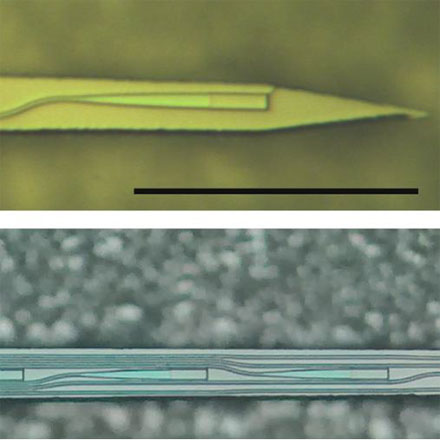An implantable, ultra-narrow photonic probe has been developed that is able to deliver light deep within brain tissues. Current methods, which project spatially patterned light via free-space optics, excite neurons within superficial layers of the cortex. Light scattering and absorption in neural tissue causes the light penetration to be extremely short, making it impossible to probe brain regions deeper than about 2 mm using free-space optical methods. The minimally invasive probe uses a combination of nanophotonics and microelectromechanical systems (MEMS) technology.

A future probe designed for brain mapping is illustrated here. Courtesy of Caltech.
A research team from California Institute of Technology (Caltech), Baylor College of Medicine, and Stanford University applied the techniques of optogenetics to develop a photonic probe that is robust, scalable and readily producible en masse. The probe uses minute cross sections to minimize tissue displacement upon implantation.
The team identified five critical requirements for realizing a widely useful, implantable photonic device, which they call the “visible-wavelength photonic probe.”
The probe had to provide multiple microscale illumination sources, each individually controllable and capable of delivering fine illumination, with cellular-scale cross-section dimensions. This patterned illumination had to be delivered with sufficient intensity to activate optogenetic effectors within the interrogated region. Associated thermal perturbations of neural tissue at or adjacent to the implanted devices had to have minimal effect on neural circuits, while the cross-sectional dimensions of the probes had to be as small as possible to reduce displacement of brain tissue upon implantation, minimize tissue damage, and suppress potential immunological response. Finally, photonic nanoprobe fabrication had to be compatible with, and ultimately transferrable to, factory-based methods for mass production.
To satisfy these requirements, the researchers developed a class of photonic probes based on integrated, silicon-based nanophotonic components adapted to operate at visible wavelengths and embedded onto implantable silicon probes patterned by MEMS processes. They employed wavelength division demultiplexing using arrayed waveguide gratings, integrated photonic waveguides, and E-pixels realized as diffractive grating couplers.
The researchers functionally validated one probe design in vivo with mice expressing channelrhodopsin-2. Highly local optogenetic neural activation was demonstrated by recording the induced response through extracellular electrical recordings in the hippocampus and two-photon functional imaging in the cortex of mice coexpressing GCaMP6.
This alternative approach to free-space optical methods is a promising paradigm for delivering and projecting high-resolution patterned light at “arbitrary depths” and with minimal perturbation in the brain. An important attribute of the novel photonic probe design is its mass producibility via existing photonics foundry protocols, which could permit the widespread deployment of the probe in the near term to the neuroscience and neuromedical research communities.
The research was published in Neurophotonics (doi: 10.1117/1.NPh.4.1.011002).